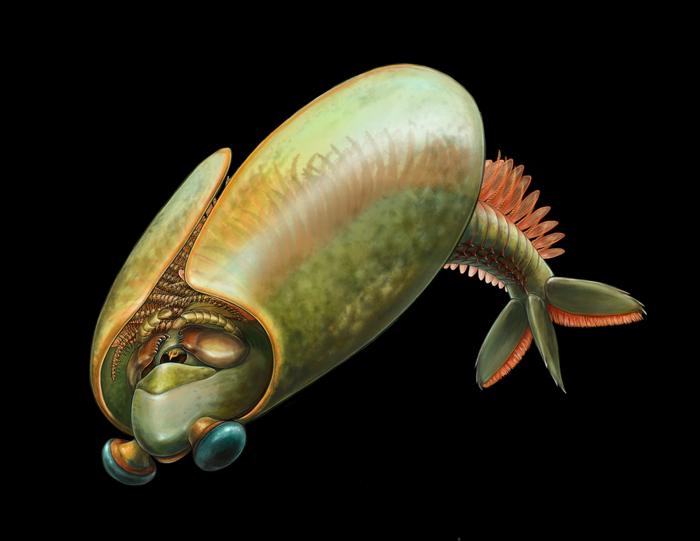A new study, led by palaeontologists at the Royal Ontario Museum (ROM) is helping resolve the evolution and ecology of Odaraia, a taco-shaped marine animal that lived during the Cambrian period. Fossils collected by ROM reveal Odaraia had mandibles. Palaeontologists are finally able to place it as belonging to the mandibulates, ending its long enigmatic classification among the arthropods since it was first discovered in the Burgess Shale over 100 years ago and revealing more about early evolution and diversification. The study The Cambrian Odaraia alata and the colonization of nektonic suspension-feeding niches by early mandibulates was published in the journal Proceedings B.

Credit: Illustrated by Danielle Dufault. Courtesy Royal Ontario Museum
A new study, led by palaeontologists at the Royal Ontario Museum (ROM) is helping resolve the evolution and ecology of Odaraia, a taco-shaped marine animal that lived during the Cambrian period. Fossils collected by ROM reveal Odaraia had mandibles. Palaeontologists are finally able to place it as belonging to the mandibulates, ending its long enigmatic classification among the arthropods since it was first discovered in the Burgess Shale over 100 years ago and revealing more about early evolution and diversification. The study The Cambrian Odaraia alata and the colonization of nektonic suspension-feeding niches by early mandibulates was published in the journal Proceedings B.
The study authors were able to identify a pair of large appendages with grasping jagged edges near its mouth, clearly indicative of mandibles which are one of the key and distinctive features of the mandibulate group of animals. This suggests that Odaraia was one of the earliest known members of this group. The researchers made another stunning discovery, a detailed analysis of its more than 30 pairs of legs, found an intricate system of small and large spines. According to the authors, these spines could intertwine, capturing smaller prey as though a fishing net, suggesting how some of these first mandibulates left the sea floor and explored the water column, setting the seeds for their future ecological success.
“The head shield of Odaraia envelops practically half of its body including its legs, almost as if it were encased in a tube. Previous researchers had suggested this shape would have allowed Odaraia to gather its prey, but the capturing mechanism had eluded us, until now,” says Alejandro Izquierdo-López, lead author, who was based at ROM during this work as a PhD student at the University of Toronto. “Odaraia had been beautifully described in the 1980s, but given the limited number of fossils at that time and its bizarre shape, two important questions had remained unanswered: is it really a mandibulate? And what was it feeding on?”
At almost 20 cm in size, the authors explain that early mandibulates like Odaraia were part of a community of large animals that could have been able to migrate from the marine bottom-dwelling ecosystems characteristic of the Cambrian period to the upper layers of the water column. These types of communities could have enriched the water column and facilitated a transition towards more complex ecosystems.
Cambrian fossils record the major divergence of animal groups originating over 500 million years ago. This period saw the evolution of innumerable innovations, such as eyes, legs or shells, and the first diversification of many animal groups, including the mandibulates, one of the major groups of arthropods (animals with jointed limbs).
Mandibulates are an example of evolutionary success, representing over half of all current species on Earth. Today, mandibulates are everywhere: from sea-dwelling crabs to centipedes lurking in the undergrowth or bees flying across meadows, but their beginnings were more humble. During the Cambrian period, the first mandibulates were marine animals, most bearing distinct head shields or carapaces.
“The Burgess Shale has been a treasure trove of paleontological information,” says Jean-Bernard Caron, Richard Ivey Curator at the Royal Ontario Museum, and co-author of the study. “Thanks to the work we have been doing at the ROM on amazing fossil animals such as Tokummia and Waptia, we already know a substantial amount about the early evolution of mandibulates. However, some other species had remained quite enigmatic, like Odaraia.”
The Royal Ontario Museum holds the largest collections of Cambrian fossils from the world-renowned Burgess Shale of British Columbia. Burgess Shale fossils are exceptional, as they preserve structures, animals and ecosystems that under normal conditions would have decayed and completely disappeared from the fossil record. Mandibulates, though, are generally rare in the fossil record. Most fossils preserve only the hard parts of animals, such as skeletons or the mineralized cuticles of the well-known trilobites, structures that mandibulates lack.
For over forty years Odaraia has been one of the most iconic animals of the Burgess Shale, with its distinctive taco-shaped carapace, its large head and eyes, and a tail that resembles a submarine’s keel. The public can view specimens of Odaraia on display at the Willner Madge Gallery, Dawn of Life at the Royal Ontario Museum.
Journal
Proceedings of the Royal Society B Biological Sciences
Subject of Research
Animals
Article Title
The Cambrian Odaraia alata and the colonization of nektonic suspension-feeding niches by early mandibulates
Article Publication Date
23-Jul-2024



